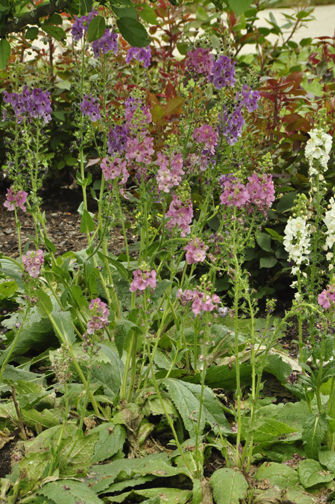This is:
A potpourri (below) of mullein/Verbascum species
information as a supplement to other articles.
A plant-based page rather than our usual topic-based page. It's
a pivot point, one list of links to ours and
others' articles that involve mulleins.
We're just introducing this set of perennial info pages. This
page is in process but Aster's
page is complete. We hope you'll take a look there and comment. Let
us know if the format was useful, share your suggestions, tell us
we shouldn't have this page at all... anything helps.
If you have a dry, sunny area you should grow mullein. Most
gardeners are familiar with the common mullein (Verbascum
thapsus), a biennial that may come in as a weed and be kept
for for its first-year appearance. That's when its huge, fuzzy,
gray leaves form a basal rosette. In its blooming year it produces
smaller leaves but its flowering stalk may reach well beyond six
feet. Too bad it has only one or two tiny yellow flowers open at
any one time.


Purple mullein, V. phoeniceum (above) is a
whole 'nother story. It's biennial or weakly perennial (will
usually bloom in its first year, and might be back in year three,
especially if kept deadheaded), has green leaves, blooms in the
cool season (spring, and may revive and bloom again in fall), is
just 18" tall in bloom and each stem is loaded with purple, rose or
white flowers.
Hybrid mulleins (right) such as the 'Cotswold' group
('Cotswold King', 'Cotswold Queen' etc.) and the 'Southern Charm'
mix are gray-foliage, biennial, 36" tall early summer
bloomers in every yellow, orange, salmon and white, sometimes
with a contrasting eye.
All the mulleins make great cut flowers. Cutting also keeps them
blooming longer, as new flowering stems will form from the base of
the cut stem, if the cutting is done before seed begins to ripen on
that stem.


Deadheading mullein
Our rule of thumb for deadheading spike-type flowers such as
mullein, hollyhock, veronica, and snapdragons is to cut each stalk
back to basal leaves as soon as more than half that stalk's length
is spent flower and developing seed. This means we cut when there
are still blooms opening at the tip, sacrificing those in order to
keep the whole plant in flower production. The cut stems still
perform well in a vase. We strip off the spent flowers and pods so
the flowers and buds at the top can shine.
Above, and in detail at right: A group of purple mullein
ripe for deadheading. Arrows mark the stem we'll remove from the
white member of the group. The lower, thicker arrow extends along
the spent part of the bloom stalk.
Read more about mullein
(Verbascum):
Topic:
subtopic: Article name/link